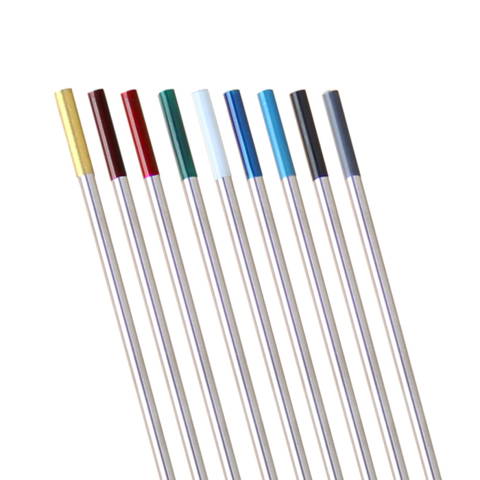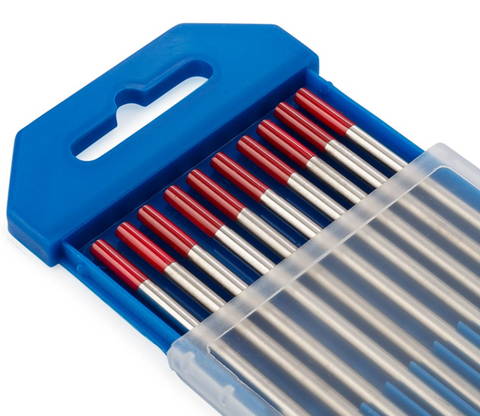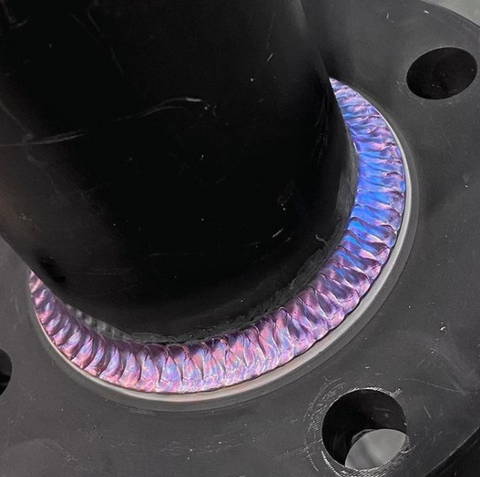Popular searches
- Welding Hose
- CO2 Regulator
- Nitrogen Regulator
- Argon Regulator
- Oxy-Acetylene

ANDREW RIPAMONTI
MAY 5, 2021
"When you choose the right tungsten, achieving the coveted 'stacked dimes' look is 100% possible. "
From novice welders to those with years of experience, TIG welding questions are inevitable. One of the most common questions we hear is, "How do I choose the right tungsten for my TIG weld?". Fact is, the world of welding is always innovating. With new and exciting techniques, tools, and products tradesmen can create impressive, strong welds that are as also pleasing to look at.
If you’re interested in elevating your own TIG welding skills, and getting the most from your welding machine, we've got the solution for you. Choosing the right TIG welding tungsten is an imperative first step. But with so many options available, it is easy to get things mixed up. Fact is, the ‘right’ tungsten for the job will vary based on a range of factors. These include the type of weld, the material(s) being welded, the thickness of the material, and the power source utilized.
No matter if you’re welding with DC or AC processes, this guide will help! We will take you through the ins and outs of which tungsten is best for the task at hand.
Tungsten Inert Gas Welding, more commonly known as TIG welding for short, utilizes tungsten-based electrodes to effectively join together various types of metals. These electrodes are vital to the process, channeling the current necessary to establish your arc.
Tungsten electrodes are often alloyed with a range of different metals, with varying sizes and types required for specific materials and welds. Further, many welders will develop a preference for one type over another, making the choice of tungsten both a practical and personal one.
Aside from material and preference for the task at hand, certain types of electrodes tend to perform better with direct current (DC). Others perform better with alternating current (AC).
Color-coding might take you back to grade school, but in this case, you’ll be glad the welding community did. Welding electrodes follow a simple color-coded method as a way to identify what’s what.
TIG welding electrodes are color classified based on the composition of the electrode. This makes them easy to find and saves you time on the job.
"With many colors to choose from it is easy to get overwhelmed. We will break down each color and explain which one you should use!"

Made from pure tungsten (99.5%), green TIG welding electrodes are most commonly used when welding magnesium or aluminum with an alternating current (AC). You’ll likely find green welding electrodes in any weld shop you visit.
Popular due to its affordability, green tungsten is cheap compared to other options. But these upfront savings will cost you in other areas. Green tungsten has a tendency to burn up at a considerably faster rate than other types of alloys. Because of this, we always suggest stocking up if you plan on using green tungsten.
Benefits of Using Green Tungsten:
·Affordable and available in bulk
·Ideal when working with AC
·Ideal for wave welding
·Forms a clean balled tip, resulting in good arc stability
·Good for magnesium and aluminum welds
Downsides of Using Green Tungsten:
·A high consumption rate means you’ll burn through them fast
·Poorer start as compared to ceriated or thoriated electrodes
·Weaker arc not ideal for DC welding
Red tungsten electrodes are a commonly used electrode revered for both its ease of use (ideal for novices), and its durability.
Red Thoriated electrodes are made from a minimum of 97.3% tungsten and 1.7-2.2% thorium. This combination is referred to as ‘2% thoriated’. An even distribution of tungsten throughout the electrode aids in establishing and maintaining a sharp edge. Red electrodes are ideal for welding thin steel and metals.
The presence of thorium improves the electrode’s electron emission qualities, enhancing arc starts and enabling the welder to achieve increased current capacity. Because red thoriated electrodes are capable of operating below its melting point, a lower burn rate (consumption rate) is achieved. This means each electrode will last a long time.
Other key features include reduced arc wandering and improved stability, while depositing less tungsten into the weld puddle.
Red tungsten is ideal for specialty AC welding, including but not limited to welding materials less than 0.0 and for thin-gauge aluminum. Red tungsten is also preferred for DC welding using straight polarity or electrode negative on nickel, steel, stainless steel and titanium.
Word of Caution: Thorium is a radioactive material. Always follow proper safety protocols and manufacturer’s instructions, as well as the Material Safety Data Sheet (MSDS).
Benefits of Using Red Tungsten:
·Durable (low consumption rate)
·Easily establish and maintains a sharp edge
·Easy to work with (ideal for novices)
·Low weld puddle contamination
·Provide good arc starts
·Higher current-carrying capacity
·Can be used for both AC and DC welding
·Good for thin metals and alloys such as titanium, steel, aluminum, nickel and more
Downsides of Using Red Tungsten:
·Thorium is radioactive, posing an additional health hazard
"Red tungsten is easy to work with and durable. However, thorium is radioactive and safety protocols must be followed."

Referred to as ‘2% Ceriated’, Grey Ceriated electrodes are made with a minimum of 97.3% tungsten combined with between 1.8-2.2% cerium.
Ideal for DC welding when using a lower current, it can also be effective with various AC welds.
Revered for impressive arc starts under low amperage, grey ceriated electrodes are popular when welding small or delicate parts. Grey electrodes are also ideal for welding thin sheet metal, pipe fabricating and more. Similar to thorium, grey tungsten is best utilized for welding titanium, nickel alloys, and steels.
Benefits of Using Grey Ceriated:
·Can be used with both DC and AC applications
·Ideal for low current welds
·Useful when working with lower temperatures
·Preferred for delicate jobs
Downsides of Using Grey Ceriated Electrodes:
·High amps can change the composition of the electrode
·Not ideal for high-temperature applications
Made from a minimum of 97.8% tungsten combined with between 1.3-1.7% lanthanum (lanthana), these ‘gold’ electrodes are often referred to as ‘lanthanated’.
Gold electrodes are most notable for their ability to produce an excellent arc start, slow consumption rate, arc stability and excellent re-ignition. They offer many of the same benefits and characteristics as their ceriated counterparts.
These electrodes are capable of working well with both DC and AC applications with an electrode-negative pointed end. They also work just as well with AC sine wave power sources when balled for use.
Capable of maintaining a well-sharpened point, lanthanated tungsten is ideal for use when welding stainless steel or other steels. They can be used on AC or DC square wave power sources.
Benefits of Using Gold Lanthanated Tungsten:
·Est. 50% greater current carrying capacity than pure tungsten
·Arc can be started and maintained at lower voltages
·Suitable for AC and DC welding
·Good arc start
·Low consumption rate
·Can weld from a square wave power source
·Versatile
Downsides of using Gold Lanthanated Tungsten:
·Not suitable for thinner metals
"Choose the correct tungsten to achieve solid welds that are also aesthetically pleasing."

Ideal for use with AC welds, the addition of zirconium to the electrode aids in resisting cracking. It simultaneously establishes a stable arc and minimizes contamination of the weld pool.
As far as amperage, it is capable of carrying a current comparable to that managed by thoriated electrodes.
Benefits of Using Brown Zirconiated Tungsten:
·Extremely stable arc
·Highly resistant to tungsten spitting
·Ideal for AC welding
·Good retention of balled tip
·High resistance to contamination
Downsides of Using Brown Zirconiated Tungsten:
·Cannot be used with DC welds
Purple / E3 Rare Earth Electrodes are specialty electrodes made (in part) from various ‘rare earth’ oxides. Need the capability of thoriated electrodes but with the added safety of something non-radioactive? A purple tungsten welding electrode might be your best bet. Made from a blending of three unique oxides, these electrodes boast improved ignition rates, a cooler run, and no radiation.
Ideal for use with both DC and AC welding jobs, these specialty electrodes need to be properly handled. Each rare earth oxide may require a unique approach when used. Often smaller, rare earth electrodes rival their counterparts. These rare earth electrodes are capable of handling similar currents, producing a stable arc, and having a low consumption rate.
Benefits of Purple / E3 Rare Earth Electrodes:
·Can be used for both AC and DC applications
·Good current capabilities
·Low consumption rate
·Great arc stability
·All the benefits of thoriated electrodes without the radiation
Downsides of Purple / E3 Rare Earth Electrodes:
·May require special approaches and techniques
·Typically more expensive
No matter the application, selecting the right type of tungsten will result in superior arc quality and enhanced performance of the weld. Each type has its advantages and downsides, but by following the tips in this guide, you can use each to your advantage.
We hope you’ve found this guide helpful. If you have questions about choosing the right tungsten electrode for your next weld job, don’t hesitate to reach out. Our team is always ready to help.
And when it comes to high-quality welding products, no one does it better than SPARC. Find out why so many professionals choose us to help them get more out of their welds. While we do not make our own TIG tungsten, our friend Jody over at Weldmonger has got you covered, with a full line of Weldmonger Tungsten Electrodes, as well as products from a number of other major brands! Check 'em out, and let them know Andrew from SPARC sent you!